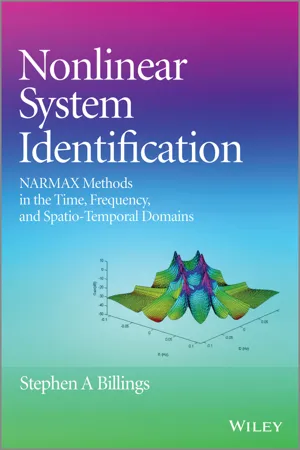
Nonlinear System Identification
NARMAX Methods in the Time, Frequency, and Spatio-Temporal Domains
- English
- ePUB (mobile friendly)
- Available on iOS & Android
Nonlinear System Identification
NARMAX Methods in the Time, Frequency, and Spatio-Temporal Domains
About this book
Nonlinear System Identification: NARMAX Methods in the Time, Frequency, and Spatio-Temporal Domains describes a comprehensive framework for the identification and analysis of nonlinear dynamic systems in the time, frequency, and spatio-temporal domains. This book is written with an emphasis on making the algorithms accessible so that they can be applied and used in practice.
Includes coverage of:
- The NARMAX (nonlinear autoregressive moving average with exogenous inputs) model
- The orthogonal least squares algorithm that allows models to be built term by term where the error reduction ratio reveals the percentage contribution of each model term
- Statistical and qualitative model validation methods that can be applied to any model class
- Generalised frequency response functions which provide significant insight into nonlinear behaviours
- A completely new class of filters that can move, split, spread, and focus energy
- The response spectrum map and the study of sub harmonic and severely nonlinear systems
- Algorithms that can track rapid time variation in both linear and nonlinear systems
- The important class of spatio-temporal systems that evolve over both space and time
- Many case study examples from modelling space weather, through identification of a model of the visual processing system of fruit flies, to tracking causality in EEG data are all included
to demonstrate how easily the methods can be applied in practice and to show the insight that the algorithms reveal even for complex systems
NARMAX algorithms provide a fundamentally different approach to nonlinear system identification and signal processing for nonlinear systems. NARMAX methods provide models that are transparent, which can easily be analysed, and which can be used to solve real problems.
This book is intended for graduates, postgraduates and researchers in the sciences and engineering, and also for users from other fields who have collected data and who wish to identify models to help to understand the dynamics of their systems.
Frequently asked questions
- Essential is ideal for learners and professionals who enjoy exploring a wide range of subjects. Access the Essential Library with 800,000+ trusted titles and best-sellers across business, personal growth, and the humanities. Includes unlimited reading time and Standard Read Aloud voice.
- Complete: Perfect for advanced learners and researchers needing full, unrestricted access. Unlock 1.4M+ books across hundreds of subjects, including academic and specialized titles. The Complete Plan also includes advanced features like Premium Read Aloud and Research Assistant.
Please note we cannot support devices running on iOS 13 and Android 7 or earlier. Learn more about using the app.
Information
Table of contents
- Cover
- Title page
- Copyright page
- Dedication
- Preface
- 1 Introduction
- 2 Models for Linear and Nonlinear Systems
- 3 Model Structure Detection and Parameter Estimation
- 4 Feature Selection and Ranking
- 5 Model Validation
- 6 The Identification and Analysis of Nonlinear Systems in the Frequency Domain
- 7 Design of Nonlinear Systems in the Frequency Domain – Energy Transfer Filters and Nonlinear Damping
- 8 Neural Networks for Nonlinear System Identification
- 9 Severely Nonlinear Systems
- 10 Identification of Continuous-Time Nonlinear Models
- 11 Time-Varying and Nonlinear System Identification
- 12 Identification of Cellular Automata and N-State Models of Spatio-temporal Systems
- 13 Identification of Coupled Map Lattice and Partial Differential Equations of Spatio-temporal Systems
- 14 Case Studies
- Index